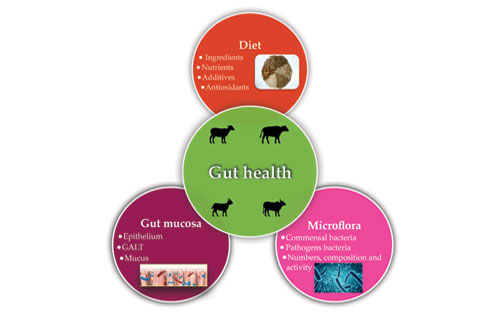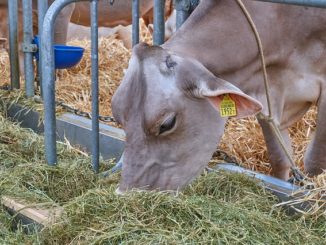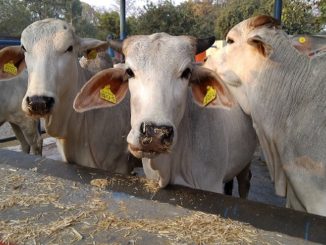Introduction
The human population is going to hit 9.2 billion by 2050. Ruminants play a crucial role in meeting the demand of animal origin foods (milk and meat). Besides, scarcity of feed resources, losses occurring due to less- and un-productive animals are the significant constraints, even though our country boasts a considerable wealth of livestock. Therefore, sustainable livestock production has been described as a mean to curb the demand of the burgeoning world population. Moreover, optimal gastrointestinal functionality and its health are the primary determinants for sustainable animal production (Celi, 2017). Over the last few decades, “gut health” has become a buzz-word in animal nutrition and gained paramount interest among the science fraternity. Gut health can be defined as the “absence of clinical diseases” in human medicine (Bischoff et al., 2011). However, the same concept does not hold good in the ruminant production system as animals’ efficiency may be deteriorated without showing any apparent signs of diseases. In this regard, our review throws limelight on the opportunities to improve gut health in the early life of animals for the long-term performance of the ruminants.
Components of gut health
As proposed by Conway (1994), there are mainly three factors governing gut health and its functionality.

1. Diet
being the major component, feed ingredients, nutrients and its additives play a substantial part in the development of gastrointestinal tract, immune system and the microbiota of ruminants. Whereas, a particular type of dietary factors adversely affects the gut health viz., anti-nutritional factors (lectins, trypsin inhibitors, mycotoxins, etc.), undigested protein in the distal tract and poor water quality (Kogut and Arsenault, 2016). Moreover, diet composition, form (pellets vs mash vs crumbles), size (fine vs coarse) influences the growth of beneficial microbes, in turn modulating the immune system. Hence, diet formulation plays a central part in gut health and directly correlated with the functions of the gastrointestinal tract (GIT) system.
Essential criteria for gut-friendly diet as follow;
- Lower levels of fermentable proteins in the hindgut (Pieper et al., 2016).
- Insignificant content of anti-nutritional factors (protease inhibitors, tannins, saponins, phytate, beta-glucans).
- Least buffering capacity.
- Inclusion of feed additives and beneficial compounds such as probiotics, prebiotics, antioxidants, vitamins, minerals, functional proteins, peptides etc (De Lange et al., 2010).
2. Gut mucosa
GIT acts as a barrier composed of mucus layer overlying intestinal epithelial cells and underneath set of Gut associated lymphoid tissue (GALT). Gut is regarded to be the most significant immunological organ of the body as it comprises more than 70% of the immune cells (Celi, 2017). When we carefully look at the intestinal structure, mainly three barriers are present viz., physical, chemical and immunological. All of these barriers interact with functional entities of the body to maintain healthy gut integrity by counteracting the pathogens (Bischoff et al., 2011).
3. Gut microflora
The intestinal microbiome is home to trillions of microorganisms representing hundreds of different species. Many factors influence the growth or suppression of these gut microflora such as age, diet, feeding pattern/format, antibiotics usage, stress, disease condition, and other managemental incidents (Yeoman and white, 2014). There should be a delicate balance between commensal and pathogenic bacteria (Figure 2); otherwise, any disturbance leads to enteric diseases. While mutualistic microbes show health benefits as follows:
- Stimulates goblet cells of the intestine to produce mucus which acts as a physical barrier.
- Triggers intestinal epithelial cells to produce tight junction proteins such as adhesin, occludin and zona occludin to maintain the integrity of GIT.
- The microbial fermentative end products like lactate decrease the pH of the hindgut, thereby suppressing the growth of harmful bacteria. Whereas, butyrate acts as a source of energy for the colonocytes.
- The commensal microbes stimulate Gut-associated lymphoid tissue (GALT) and Mucosal-associated lymphoid tissue (MALT) which in turn produce antibodies to fight against pathogens (Wood et al., 2015).
Impact of gut on host health
Gastrointestinal tract performs a variety of functions in the body. It ensures effective digestion, absorption of nutrients, minerals and fluid uptake; regulates primary immune and epithelial functions of prominence for overall health in general and gut health. Gut connects to the brain via the vagus nerve and controls release of hormones that affect hormones and well-being of the animal in general (Malmuthuge et al., 2017). It should be noted that when an animal come across pathogens, the immune system is triggered. Any Inflammation in GIT consumes ideal protein costs of 0.27g per kg body weight/day and productivity loss amounting to 10% of the nutrient use during an acute phase immune response (Rodriguez et al., 2015). Estimated nutrient cost during ongoing inflammatory processes to be 1.3 times that of maintenance which results in lower feed efficiency, reduced animal growth and ultimately higher cost of production for farmers. Hence, any disease associated with gut health is costly and need to be dealt with utmost importance.
Association between gut microbiota and enteric infections in calves
Calves being the future replacement stock of the herd, it is a challenging task for the farmers to raise them as disease-free newborns. Neonatal diarrhoea is the major factor and accounts for more than 50% death of dairy calves during the initial weeks of life (Cho and Yoon, 2014). Several existing kinds of the literature suggest that there is a possible link between host health and gut microbiota. For example, calves affected with diarrhoea and pneumonia had lower bacterial diversity than the healthy calves. In modern intensive dairy farming, colostrum is fed immediately after birth. Feeding poor quality (IgG, <50 mg/ml) and contaminated (coliform count > 103 CFU/ml) colostrum may adversely affect health and passive immunity (Hang, 2017). Therefore, maintaining the gut health of neonatal calves is imperative to prevent mortality and morbidity due to enteric infections.

Opportunities to improve the gut health of ruminants
Within the livestock industry, several feed additives are used for the augmentation of gut health in ruminants for better health and production. Nevertheless, we propose three P’s for gut health: Prebiotics, probiotics and polyphenols.
1. Prebiotics
These are the selectively digestible feed ingredients, which promotes the growth of beneficial microbes by providing required substrates. The example includes Mannan oligosaccharides (MOS), Fructose oligosaccharides (FOS), Galactose oligosaccharides (GOS). About 90% of the oligosaccharides escapes digestion and reach the colon, where they selectively stimulate the activity of gut microflora.
Mechanism of action
- Lower the pH of hindgut through the production of lactic acid.
- Modulate mucin production in the intestinal epithelial cells.
- Prevent/ inhibit colonization of pathogenic bacteria either by directly binding or increasing the intestinal lumen osmotic value.
2. Probiotics
“The live microorganisms which when administered in adequate amount confers health benefits on animals” (Malmuthuge, 2017). In neonatal calves, antibiotics are given indiscriminately to treat enteric infections which cause the emergence of antimicrobial resistance. In this context, probiotics can be used as “the 21st century’s antibiotics/biotherapeutics” which confers health benefits on the host. Efficacy of probiotics depends on their dosage, duration and timing of the administration. Species-specific multi-strain probiotics are more persistent than the different origin single-strain probiotics (Yeoman and white, 2014).
Different forms of probiotics
There are two forms- dry and liquid:
- Dry powder form – probiotics are manufactured in powder using lyophilization technology and encapsulated to maintain the viability during storage. Coated probiotics are stable, and there is no loss of activity up to 6 months if stored at 4°C. However, they should be fed along with the feed as early as possible (Frizzo et al., 2010).
- Liquid form – we can feed directly as a broth medium containing 24-48 hr live cultures or fermented milk as dahi. It should be delivered immediately as viability decreases due to exposure to the environmental conditions.
Practical use of probiotics
- Administer once or twice daily till the bacteria establishes itself in the GIT and replace the pathogenic bacteria by competitive exclusion.
- Regularly probiotics should be supplemented as it is practically impossible that probiotic bacteria could persist permanently in the stable alimentary canal system.
- Greater effect seen during the period when gut microflora is unstable viz., after weaning and after an extended period of treatment of antibiotics.
3. Polyphenols
They belong to a class of phytochemicals which include secondary plant metabolites, catechin, tannin and chlorogenic acids which are the typical components of animal diets. They play a potential role in modulating gut health by exerting antioxidant and anti-inflammatory properties. Typically present in various parts of the plant like flowers, fruits, roots, seeds and leaves of vegetables, legumes etc. They contribute to host health by a) maintaining the intact epithelial barrier function, b) balance of gut microbiota, c) prevent the entry of harmful bacteria or their substrates entering the circulation, and d) stabilizes the cell membranes against reactive oxygen species (ROS) (Malmuthuge, 2017).
Conclusion
Optimal functionality of the gastrointestinal tract and its health is crucial for sustainable animal production. Animal performances are determined by an intricate relationship among feed-based interventions, mucosal immunology, and the healthy gut microbiome. Therefore, formulating a diet with novel additives (Probiotics, prebiotics, and polyphenols) summarizes as a valid option in the effective digestion, absorption of nutrients, and ultimately optimized performance. However, these dietary manipulations give short period results. Future research must be focused on the impact of early life nutrition on calves’ gut health and animals’ lifetime performance.
References
- Bischoff, S. C. (2011). ‘Gut health’: a new objective in medicine?. BMC medicine, 9(1): 24.
- Celi, P., Cowieson, A. J., Fru-Nji, F., Steinert, R. E., Kluenter, A. M., and Verlhac, V. (2017). Gastrointestinal functionality in animal nutrition and health: new opportunities for sustainable animal production. Animal Feed Science and Technology, 234: 88-100.
- Cho, Y. I., and Yoon, K. J. (2014). An overview of calf diarrhea-infectious etiology, diagnosis, and intervention. Journal of veterinary science, 15(1): 1-17.
- Conway, P. L. (1994). Function and regulation of the gastrointestinal microbiota of the pig. Publication-European Association For Animal Production, 80: 231-231.
- De Lange, C. F. M., Pluske, J., Gong, J., and Nyachoti, C. M. (2010). Strategic use of feed ingredients and feed additives to stimulate gut health and development in young pigs. Livestock Science, 134(1-3): 124-134.
- Frizzo, L. S., Soto, L. P., Zbrun, M. V., Bertozzi, E., Sequeira, G., Armesto, R. R. and Rosmini, M. R. (2010). Lactic acid bacteria to improve growth performance in young calves fed milk replacer and spray-dried whey powder. Animal Feed Science and Technology, 157(34): 159-167.
- Hang, B. P. T., Dicksved, J., Sjaunja, K. S., and Wredle, E. (2017). Colostrum quality, IgG absorption and daily weight gain of calves in small-scale dairy production systems in Southern Vietnam. Tropical animal health and production, 49(6): 1143-1147.
- Kogut, M. H., and Arsenault, R. J. (2016). Gut health: The new paradigm in food animal production. Frontiers in veterinary science, 3: 71.
- Malmuthuge, N. (2017). Understanding host-microbial interactions in rumen: searching the best opportunity for microbiota manipulation. Journal of animal science and biotechnology, 8(1): 8.
- Pieper, R., Tudela, C. V., Taciak, M., Bindelle, J., Pérez, J. F., and Zentek, J. (2016). Health relevance of intestinal protein fermentation in young pigs. Animal health research reviews, 17(2): 137-147.
- Rodriguez, J. M., Murphy, K., Stanton, C., Ross, R. P., Kober, O. I. and Juge, N., (2015). The composition of the gut microbiota throughout life, with an emphasis on early life. Microbial Ecology in Health Diseases, 26: 26050.
- Wood, K. M., Palmer, S. I., Steele, M. A., Metcalf, J. A., and Penner, G. B. (2015). The influence of age and weaning on permeability of the gastrointestinal tract in Holstein bull calves. Journal of dairy science, 98(10): 7226-7237.
- Yeoman, C. J., and White, B. A. (2014). Gastrointestinal tract microbiota and probiotics in production animals. Annual Review of Animal Bioscience, 2(1): 469-486.







Very good article